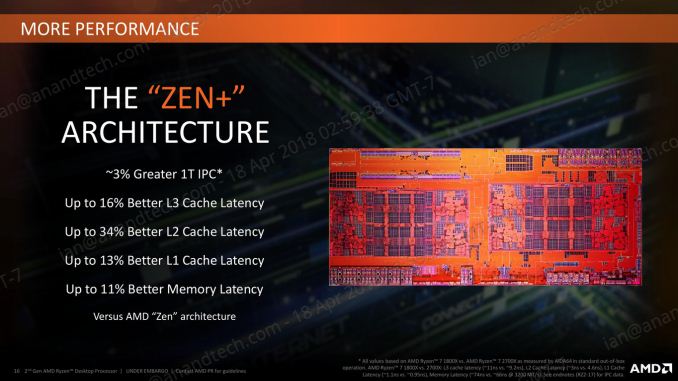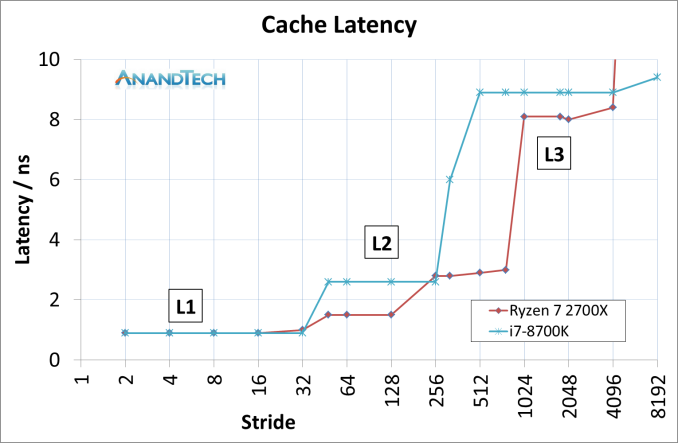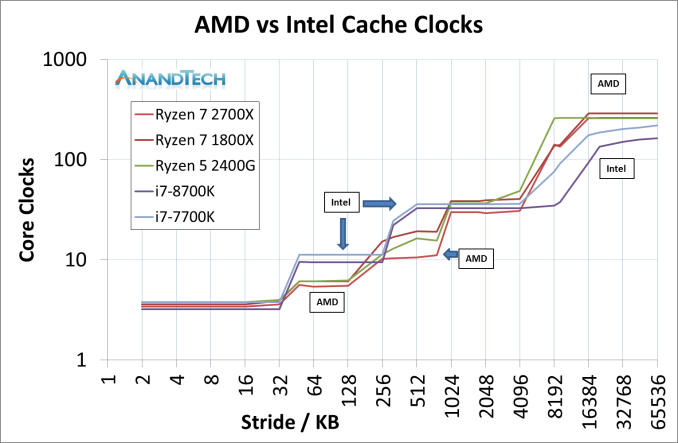The AMD 2nd Gen Ryzen Deep Dive: The 2700X, 2700, 2600X, and 2600 Tested
by Ian Cutress on April 19, 2018 9:00 AM ESTImprovements to the Cache Hierarchy
The biggest under-the-hood change for the Ryzen 2000-series processors is in the cache latency. AMD is claiming that they were able to knock one-cycle from L1 and L2 caches, several cycles from L3, and better DRAM performance. Because pure core IPC is intimately intertwined with the caches (the size, the latency, the bandwidth), these new numbers are leading AMD to claim that these new processors can offer a +3% IPC gain over the previous generation.
The numbers AMD gives are:
- 13% Better L1 Latency (1.10ns vs 0.95ns)
- 34% Better L2 Latency (4.6ns vs 3.0ns)
- 16% Better L3 Latency (11.0ns vs 9.2ns)
- 11% Better Memory Latency (74ns vs 66ns at DDR4-3200)
- Increased DRAM Frequency Support (DDR4-2666 vs DDR4-2933)
It is interesting that in the official slide deck AMD quotes latency measured as time, although in private conversations in our briefing it was discussed in terms of clock cycles. Ultimately latency measured as time can take advantage of other internal enhancements; however a pure engineer prefers to discuss clock cycles.
Naturally we went ahead to test the two aspects of this equation: are the cache metrics actually lower, and do we get an IPC uplift?
Cache Me Ousside, How Bow Dah?
For our testing, we use a memory latency checker over the stride range of the cache hierarchy of a single core. For this test we used the following:
- Ryzen 7 2700X (Zen+)
- Ryzen 5 2400G (Zen APU)
- Ryzen 7 1800X (Zen)
- Intel Core i7-8700K (Coffee Lake)
- Intel Core i7-7700K (Kaby Lake)
The most obvious comparison is between the AMD processors. Here we have the Ryzen 7 1800X from the initial launch, the Ryzen 5 2400G APU that pairs Zen cores with Vega graphics, and the new Ryzen 7 2700X processor.
This graph is logarithmic in both axes.
This graph shows that in every phase of the cache design, the newest Ryzen 7 2700X requires fewer core clocks. The biggest difference is on the L2 cache latency, but L3 has a sizeable gain as well. The reason that the L2 gain is so large, especially between the 1800X and 2700X, is an interesting story.
When AMD first launched the Ryzen 7 1800X, the L2 latency was tested and listed at 17 clocks. This was a little high – it turns out that the engineers had intended for the L2 latency to be 12 clocks initially, but run out of time to tune the firmware and layout before sending the design off to be manufactured, leaving 17 cycles as the best compromise based on what the design was capable of and did not cause issues. With Threadripper and the Ryzen APUs, AMD tweaked the design enough to hit an L2 latency of 12 cycles, which was not specifically promoted at the time despite the benefits it provides. Now with the Ryzen 2000-series, AMD has reduced it down further to 11 cycles. We were told that this was due to both the new manufacturing process but also additional tweaks made to ensure signal coherency. In our testing, we actually saw an average L2 latency of 10.4 cycles, down from 16.9 cycles in on the Ryzen 7 1800X.
The L3 difference is a little unexpected: AMD stated a 16% better latency: 11.0 ns to 9.2 ns. We saw a change from 10.7 ns to 8.1 ns, which was a drop from 39 cycles to 30 cycles.
Of course, we could not go without comparing AMD to Intel. This is where it got very interesting. Now the cache configurations between the Ryzen 7 2700X and Core i7-8700K are different:
| CPU Cache uArch Comparison | ||
| AMD Zen (Ryzen 1000) Zen+ (Ryzen 2000) |
Intel Kaby Lake (Core 7000) Coffee Lake (Core 8000) |
|
| L1-I Size | 64 KB/core | 32 KB/core |
| L1-I Assoc | 4-way | 8-way |
| L1-D Size | 32 KB/core | 32 KB/core |
| L1-D Assoc | 8-way | 8-way |
| L2 Size | 512 KB/core | 256 KB/core |
| L2 Assoc | 8-way | 4-way |
| L3 Size | 8 MB/CCX (2 MB/core) |
2 MB/core |
| L3 Assoc | 16-way | 16-way |
| L3 Type | Victim | Write-back |
AMD has a larger L2 cache, however the AMD L3 cache is a non-inclusive victim cache, which means it cannot be pre-fetched into unlike the Intel L3 cache.
This was an unexpected result, but we can see clearly that AMD has a latency timing advantage across the L2 and L3 caches. There is a sizable difference in DRAM, however the core performance metrics are here in the lower caches.
We can expand this out to include the three AMD chips, as well as Intel’s Coffee Lake and Kaby Lake cores.
This is a graph using cycles rather than timing latency: Intel has a small L1 advantage, however the larger L2 caches in AMD’s Zen designs mean that Intel has to hit the higher latency L3 earlier. Intel makes quick work of DRAM cycle latency however.














545 Comments
View All Comments
mapesdhs - Monday, May 14, 2018 - link
You know what will happen there though, yet more accusations of conspiracy, etc.lfred - Wednesday, April 25, 2018 - link
Could anyone confirm the Wraith Prism cooler height 9.4cm , (and therefore wont fit a Silverstone Raven Z Mini-ITX case ) . thank youpsychok9 - Wednesday, April 25, 2018 - link
Hello Ian, is there any news this week?ET - Wednesday, April 25, 2018 - link
I'm still waiting for the StoreMI page.Sx57 - Wednesday, April 25, 2018 - link
Well i am still waiting for anandtech updating the article.i am very interested to know how ryzen beat coffelake so well.i believe anandtech review is perfomed rightly but i wanna know what is actually wrong with other reviews that make intel winner in some games.it seems not to be the security patches related.FaultierSid - Wednesday, April 25, 2018 - link
Did they just silently switch out all gaming benchmarks? Intel 8700K now winning across the board.rocky12345 - Wednesday, April 25, 2018 - link
Yep they sure did they must have redone the tsts but this time turned on MCE for Intel and upped the memory clock to at least 3200MHz for Intel as well to see those kinds of gains in games from the old charts from last week. If they decide to explain it they will spin it that oh they had the wrong data points in the charts for Intel...lolTEAMSWITCHER - Wednesday, April 25, 2018 - link
Yes .. at 1080P. The 4K gaming results are rather mixed. So the original conclusion still stands for me. The AMD Ryzen 2700X is roughly on par with the 8700K at 4K gaming, and pulls ahead in productivity applications.RafaelHerschel - Wednesday, April 25, 2018 - link
Here is how I see it, at 1080p the new Ryzen results are good enough for 60 FPS gaming. The 2600 (non-x model) sometimes drops below 60 FPS but for a system that is equally used for productivity and gaming, I can certainly live with that. For a system that is mainly used for gaming, I still prefer Intel, but by a slimmer margin than before.mapesdhs - Monday, May 14, 2018 - link
You are hereby awarded the Sensible Chap medal for mentioning 60Hz gaming in at least a non-negtive manner. 8) A few pages back, one guy described anything below 144Hz as useless.